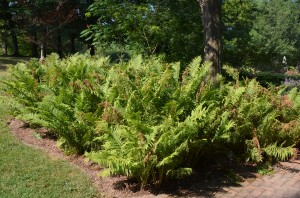For sheer toughness ostrich fern (Matteuccia struthiopteris) handles most landscape situations (USDA hardiness zones 2-7a). Ostrich fern is commonly seen growing naturally in cool moist river bottom soils, 3-5 feet in height and spreading aggressively. Roots have a clumping rhizomatous nature. The fronds grow upright with a slightly arching form, typically to 2-3 feet in height under average garden care.
Ostrich fern is a deciduous fern which prefers moist, well-drained, slightly acidic to low alkaline pH soils in full to partial shade. It is no fan of drought, high heat and humidity and can only survive in cool moist shade in southern zone 7-a.
Ostrich fern earns its name for their feathery long “ostrich -like plumes”. In early spring the vegetative fronds emerge from a narrow pedestal or base as “fiddleheads”, which unfurl to a maximum length of 3-4 feet. The emerging fiddleheads (new fronds) are said to be quite delicious sautéed in oil or butter. By mid-summer the 2 foot spike-like fertile fronds arise in the center and turn dark brown and woody by late summer.
Well-established 2-3 year old clumps can survive in non-irrigated ground, but the vegetative fronds may appear brown and tattered. Medium green fronds mature to dark brown in mid- to late autumn.
No serious insect or disease problems trouble them. Group several together in moist woodland areas or adjacent to streams or ponds. Plant ostrich ferns with other shade garden favorites such as heucheras, astilbes, lungworts (Pulmonaria), hostas, and hakone grass.


 Posted in
Posted in 
